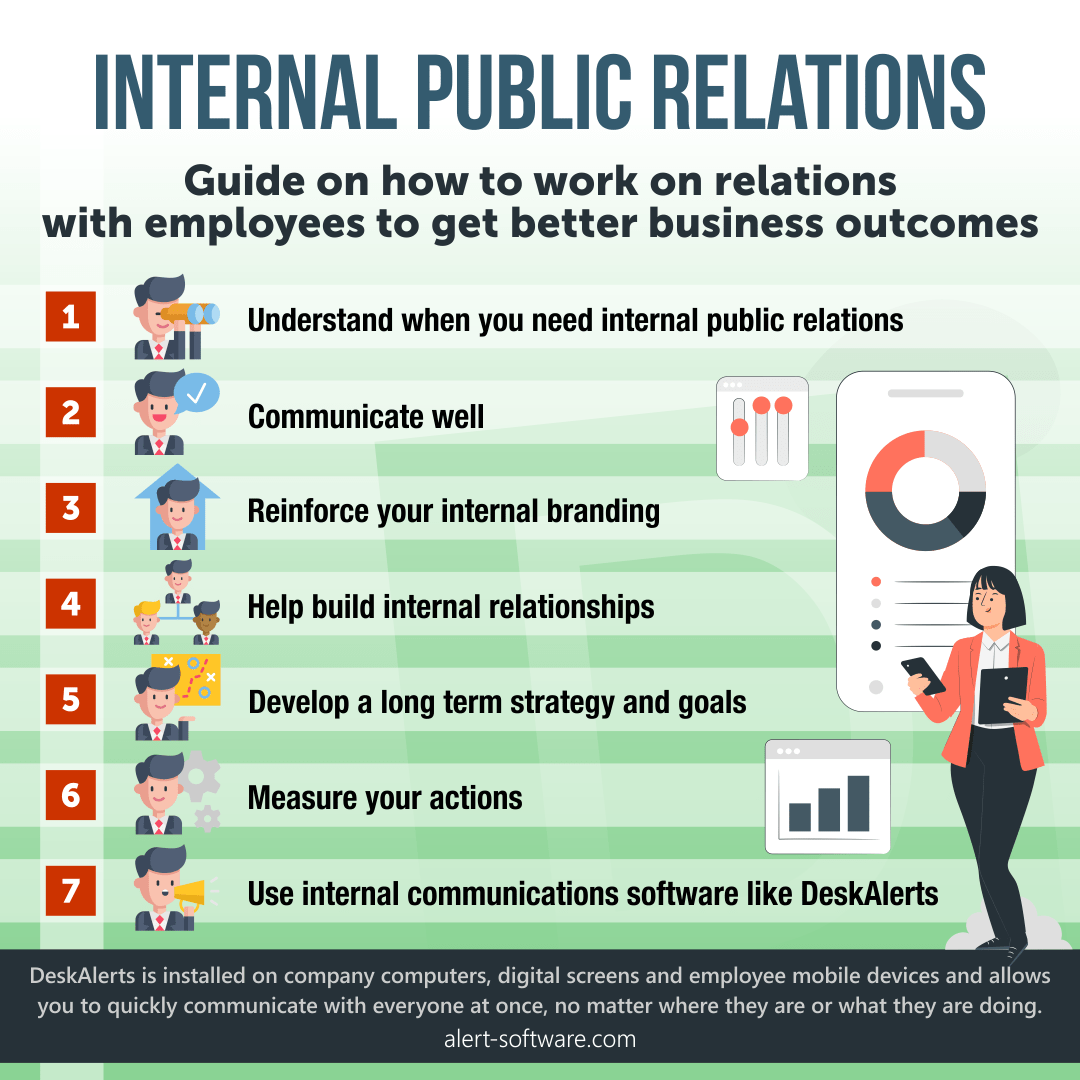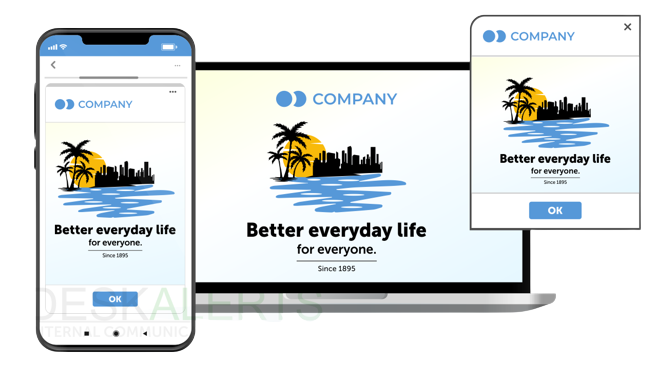 When you think about public relations, you probably almost immediately think about the work that a company does to present itself in a favorable light with customers, stakeholders and the general public. However, there is a branch of public relations that doesn’t get as much attention but is equally as important: internal public relations.
When you think about public relations, you probably almost immediately think about the work that a company does to present itself in a favorable light with customers, stakeholders and the general public. However, there is a branch of public relations that doesn’t get as much attention but is equally as important: internal public relations.
The importance of internal communication in business cannot be understated – it ensures that your most valuable stakeholders, your employees, are kept informed and information is presented in a way that makes them excited about and engaged with the company.
Table of contents
What is internal public relations?
When do you need internal public relations?
Difference Between Internal Communications and Internal PR
How Intranet Software Facilitates Internal PR
Why is internal public relations important?
Your guide to internal public relations
Companies with good public relations understand the value of these activities - how they present themselves to the outside world so that they can build trust and a reputation that makes people want to be loyal to their brand. Unfortunately, many companies don’t use the same approach with their internal audiences and don’t see the importance of internal public relations. This means they are missing out on the benefits of developing the same relationships and loyalty with their own employees.
What is internal public relations?
Internal public relations is a sphere of internal communications. What is internal communication? On the whole, internal communications cover the way that information is delivered within a company, from top to bottom, from bottom to top and among different teams and departments. The information can be about positive initiatives or could also be about bad news.
Within the internal communications spectrum, internal public relations is mostly concerned with accentuating the positive – or trying to ensure negative issues are presented in the most positive way possible.
Internal public relations seeks to present the company in a good light in the eyes of its employees. It helps staff to understand the organization’s vision, mission and goals and realize the role that they have to play as individuals to help the company be successful. By using consistent internal messages, employees will understand the “big picture” and be engaged and motivated, more productive and more likely to recommend the company to family and friends.
Why is internal public relations important?
There are many positive reasons to incorporate an internal public relations strategy into your overall internal communications planning. Treating your internal audience as valued stakeholders can help to establish trust, and enhance employee engagement levels, while also improving knowledge sharing so that employees are better informed.
A strong internal public relations program helps to enhance your external public relations efforts. If the “face” your company puts on for the public isn’t the same as the one its employees' experience, it can make employees mistrustful, cynical and affect morale. And in today’s climate where disaffected employees can expose the reality of life at the company on social media, it can actually lead to a public relations headache if you treat your internal audience differently.
Internal public relations helps you to establish your internal brand and engage in authentic, meaningful communications with your employees. This will help them feel motivated, and can even assist to turn them into brand ambassadors for your company. This includes recommending your company as a great place to work, increasing loyalty and retention, and promoting the company’s products and services willingly to people that they know.
When do you need internal public relations?
Internal public relations should be an ongoing activity with a long-term strategy that underpins your employee communication and engagement programs. There are, however, some circumstances where you need to undertake internal public relations campaigns in order to keep employees informed.
1. When your company is implementing major changes
Change can be difficult for employees, and the majority of change initiatives are doomed to fail. When you have engaged employees who are receptive to internal public relations messaging you’ll have an audience that is better able to understand the benefits of the change and be more inclined to embrace the change.
2. When you have big news to share
Your employees shouldn’t find out about major news that affects your company from media or social media first. You should always communicate major news to your staff first. When they hear it second-hand they are likely to feel resentful and neglected.
3. Sharing successes and achievements
Whatever form this takes, you should promote your company’s success stories to your employees. If you’ve done something innovative, achieved your KPIs, or reached milestones on projects, celebrate it together. Recognizing individual and team achievements is also crucial and will help to build morale.
4. To enhance your employer's brand
Developing a strong brand identity as an employer is one of the keys to becoming an employer of choice and attracting a pool of talented candidates who want to work for your company because they’ve heard great things about it! Internal public relations work within the company to help achieve this.
5. In your general internal communications
A lot of internal communications is made up of administrative reminders about new policies, deadlines, HR requirements, IT notifications, internal events, training, onboarding and so on. While these aren’t strictly an internal public relations responsibility, they should be approached and delivered through the lens of internal public relations. That is, the communication should be positive, employee-centric and portray the company positively.

Difference Between Internal Communications and Internal PR
Internal Communications and Internal Public Relations (Internal PR) are both crucial components of an organization's communication strategy, but they serve different purposes and have distinct approaches:
Internal Communications:
-
Purpose: The primary goal is to ensure the flow of information within the organization. This includes sharing company news, updates, policies, and other essential information that employees need to know to do their jobs effectively.
-
Focus: Internal communications are often about day-to-day operations and ensuring that employees are informed and aligned with the organization's goals.
-
Channels: It can include emails, newsletters, intranets, team meetings, internal messaging platforms, and other tools that facilitate information sharing.
-
Tone: The tone is typically straightforward, informational, and sometimes directive, depending on the nature of the communication.
Internal PR:
-
Purpose: Internal PR aims to build a positive image of the company among its employees, fostering a sense of pride, loyalty, and engagement. It is about managing the company's reputation internally and ensuring that employees see the organization in a positive light.
-
Focus: While it includes elements of communication, internal PR is more about shaping perceptions and promoting the company’s values, culture, and achievements. It’s about creating an internal brand that employees want to be a part of.
-
Channels: Internal PR uses storytelling, employee recognition programs, internal events, leadership messages, and other initiatives to create a positive narrative within the company.
-
Tone: The tone is often more engaging, inspirational, and focused on building emotional connections with employees.
How Intranet Software Facilitates Internal PR
Intranet software plays a significant role in facilitating internal PR by providing a centralized platform where the organization's internal branding efforts can be effectively communicated and reinforced. Here’s how it helps:
1. Centralized Communication Hub
Intranet software serves as a central hub for all internal communications, allowing employees to access company news, updates, and announcements. It ensures that all employees receive consistent messaging, which is crucial for maintaining a strong internal brand.
2. Employee Engagement
Intranet platforms often include features like blogs, forums, and social spaces where employees can share their stories, achievements, and feedback. These features help in building a sense of community and belonging, which is a key aspect of internal PR.
3. Recognition and Rewards
Many intranet systems have built-in tools for employee recognition and rewards. Highlighting employee achievements and contributions publicly on the intranet reinforces positive behavior and aligns with the internal PR strategy of promoting a positive company culture.
4. Leadership Communication
Intranet software allows for direct communication from leadership to all employees. Regular updates from the CEO or other leaders can be shared, showcasing the company’s vision, successes, and future goals, thereby reinforcing the internal PR narrative.
5. Content Management
Intranet software provides tools for creating and managing content such as articles, videos, and newsletters that can be used to promote the company’s values, culture, and achievements internally. This content can be carefully curated to align with the internal PR strategy.
6. Feedback Mechanisms
Effective internal PR requires understanding employee sentiments. Intranets often include surveys, polls, and feedback tools that allow employees to share their opinions and feelings, which can be invaluable for shaping internal PR efforts.
7. Visual Branding
Intranets can be customized to reflect the company’s brand, with consistent use of logos, colors, and messaging. This visual consistency helps reinforce the company’s identity and values, contributing to a strong internal brand image.
By integrating these features, intranet software becomes a powerful tool in an organization’s internal PR efforts, helping to build a cohesive and positive internal culture.
Your guide to internal public relations
Unfortunately, many organizations fail to account for internal public relations at all, even if they have excellent external public relations. The good news is, that if you don’t already have an internal public relations strategy in place, it is relatively easy to implement one. This guide can help you to deliver effective internal public relations in your organization.
1. Make sure you’ve got the communication basics right
When you’re communicating with the staff you should follow the golden rules for internal communications:
- Communicate clearly, and concisely in a way that is easily understood
- Make sure your communication is professional
- Make sure your communication is timely
- Don’t withhold important information – transparency is important
- Company leadership should be visible
- Communication should be regular
- Use a range of internal communication tools to ensure your information is received
2. Start from the very beginning with employees
Your internal public relations activities should influence the employee onboarding experience (including online onboarding) so that new recruits are exposed to this aspect of your brand from their very first day with the organization.
3. Create customized in-house learning and development opportunities
When you’re providing training opportunities to your staff you can deliver tailored educational solutions that reflect your brand and help to build morale. This might be having your CEO or other senior executives join in the training, or even addressing the audience at the beginning.
4. Create visual content for internal audiences and reinforce your internal branding
Use different visual methods to reinforce your internal public relations campaigns and messaging to your employees in the workplace. These internal public relations activities examples include designing posters, digital signage displays, infographics, flyers, corporate wallpapers and screensavers and other branded material. It helps to solidify your external branding internally.
Your internal branding campaign isn’t just the colors, logos and graphic design that you use in your internal public relations efforts: it's also about being true to your company values, vision, mission and goals. Your internal public relations should always aim to reflect these things.
5. Help build internal relationships
When you’re responsible for internal public relations, you’re uniquely placed to develop relationships with key people across your organization. When you establish buy-in from the executive team you can also get support for internal public relations initiatives.
Providing your employees with opportunities to get to know one another better in an informal setting can help to build and strengthen positive working relationships. This isn’t just for peer-to-peer relationships: it can also help management and employees get to know one another better in a less intimidating environment.
6. Ensure that there is two-way communication
It’s important that employees have a voice and can be heard by management. They are at the coal face of operations in your business, and management can sometimes be detached from the reality of day-to-day business. By listening to employees you are showing that you value their opinions.
7. Develop a long-term strategy and goals
Internal public relations shouldn’t be a quick fix to any company issues: you need to play the long game. This means it is important to develop an appropriate internal public relations strategy and long-term goals that align with the company’s overall goals.
8. Measure your actions
It’s important to define what the criteria will be for measuring your successes and how to evaluate the results against these criteria. This will help you to determine where you can improve on an ongoing basis.
9. Use internal communications software like DeskAlerts
DeskAlerts is an internal communications software system that is perfect for use in internal public relations activities. The system is installed on company computers, digital screens and employee mobile devices and allows you to quickly communicate with everyone at once, no matter where they are or what they are doing.
DeskAlerts features different communication channels that can boost the effectiveness of internal communication activities:
- Pop-up alerts are designed to cut through the electronic noise to reach employees in real time, to deliver important information. Messages can’t be skipped or ignored, unlike email.
- Scrolling desktop tickers – a narrow band of text that scrolls across the screen and can be used to deliver headlines and links to further information.
- Corporate screensavers and wallpapers that can contain your branding and provide messaging in a colorful and engaging way.
- Digital signage that will turn any digital screen in your organization into an electronic billboard, and can be used to promote any internal public relations initiatives in a creative and eye-catching way.
***
Internal public relations is important for successful businesses to communicate with their employees, keeping them well-informed and engaged.
Frequently Asked Questions
Why are good public relations (PR) so important?
Public relations is important to build on your company’s marketing strategies and to ensure that you send the right messages, to the right people at the right time. It helps to strengthen the reputation of your brand and contributes heavily to the overall success of the organization.
Why is internal public relations important?
Internal public relations has an important role to play in the success of a company. When communication is ineffective, employees are not unified and working well together to achieve goals. Mistakes can be made, productivity and profitability lowered, and it can also result in employees who are disengaged, unmotivated and unhappy.
What is internal public relations?
Internal public relations refers to the promotional communication that takes place within an organization. It is designed to ensure that your employees love working for your company, and are happy and engaged.
What are the top three benefits of having an internal communications department?
The top three benefits of having an internal communications department in your organization are:
- The ability to respond quickly to any emergencies, problems or issues.
- The ability to ensure that you have better informed employees who understand what is expected of them in contributing to the company’s goals and successes.
- More highly engaged employees who are likely to be more productive, profitable and likely to keep working for your company into the future.
What is internal public in public relations?
The internal public in public relations refers to the internal audience: this is generally employees and contractors and anyone else who has a significant role to play in delivering goods and services on behalf of your company.
What is the main objective of internal PR?
The main internal PR purpose is to present your company in a positive way to employees so that they are loyal to your brand.
 Caroline Duncan
Caroline Duncan
 When you think about public relations, you probably almost immediately think about the work that a company does to present itself in a favorable light with customers, stakeholders and the general public. However, there is a branch of public relations that doesn’t get as much attention but is equally as important: internal public relations.
When you think about public relations, you probably almost immediately think about the work that a company does to present itself in a favorable light with customers, stakeholders and the general public. However, there is a branch of public relations that doesn’t get as much attention but is equally as important: internal public relations.






